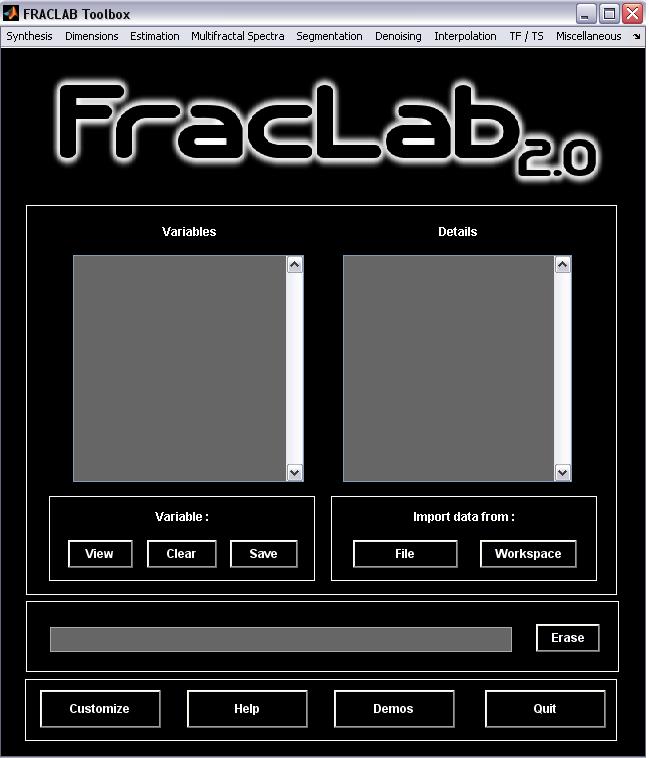Softwares (Design, Development and Supervisory control)
FracLab (Research, Design and Development)
FracLab is a general purpose signal and image processing
toolbox based on fractal and multifractal methods.
FracLab can be approached from two different perspectives :
Fractal analysis:
A large number of procedures allow to compute various fractal
quantities associated with 1D or 2D signals, such as dimensions,
Holder exponents or multifractal spectra.
Signal processing:
Alternatively, one can use Fraclab directly to perform many
basic tasks in signal processing, including estimation, detection,
denoising, modelling, segmentation,classification, and synthesis.
FracLab is a free software developped in the APIS team at Inria Saclay under the supervision of Jacques Levy-Vehel. It mainly consists of routines developped in C-code interfaced with Matlab and Scilab (a free scientific software package for numerical computations from INRIA). It runs under Linux and Windows environments.


Here are links to some papers (or only abstracts, depending on the case) that acknowledge the use of FracLab.
Hevea Software (Research, Design and Development)
Cochlear implants are devices that become more and more sophisticated and adapted to the need of patients, but at the same time they become more and more difficult to parameterize. After a deaf patient has been surgically implanted, a specialised medical practitioner has to spend hours during months to precisely fit the implant to the patient. This process is a complex one implying two intertwined tasks: the practitioner has to tune the parameters of the device (optimisation) while the patient's brain needs to adapt to the new data he receives (learning). This software intends to make the implant more adaptable to environment (auditive ecology) and to simplify the process of fitting. Real experiments on volunteer implanted patients prooved the efficiency of this software for this purpose. This work has partially been funded by the French ANR - RNTS HEVEA project 04T550.
VCN analysis (Research, Design and Development)
Logiciel pour la visualisation de potentiels évoqués (signaux EEG). J'ai réalisé ce logiciel dans le cadre du projet PSI (Appel Neuroinformatique du CNRS et PSI REGION). Il s'agissait de fournir aux partenaires un outil permettant de visualiser et mesurer le niveau de relaxation d'un individu par moyennage d'activité cérébrale suite à un enchainement de stimulis. Cet outil nous a permis de valider les données utilisées lors de la thèse de Laurent Vézard.
![]()
HUman MOnitoring (HUMO) software (Research, Design and Development)
Logiciel pour l’acquisition simultanée de signaux bio-médicaux provenant de divers capteurs (EEG, ECG, EDA, PUPILLO). J'ai réalisé ce logiciel dans le cadre des micro-projets HUMO soutenus par le GIS ALBATROS.

Interface graphique du logiciel HUMO

Montage Hardware HUMO
Acquisition de signaux EEG en temps réel. Démo.
Quelques commentaires sur le logiciel HUMO. Première présentation aux partenaires.
Présentation d'un logiciel développé pour l'analyse des données HUMO (stage de Luis Martin Herrera Lezama).
Biips: Bayesian inference with interacting particle systems (design and development by A. Todeschini)
The main factor in the success of MCMC methods is that they can be implemented with little efforts in a large variety of settings. Many softwares have been developed such as WinBUGS and JAGS, that helped to popularize Bayesian methods. These softwares allow the user to define his statistical model in a so-called BUGS language, then runs MCMC algorithms as a black box. Although SMC methods have become a very popular class of numerical methods over the last 20 years, there is no such \black box software" for this class of methods. The BiiPS software aims at bridging this gap. From a graphical model defined in BUGS language, it automatically implements SMC algorithms and provides summaries of the posterior distributions.